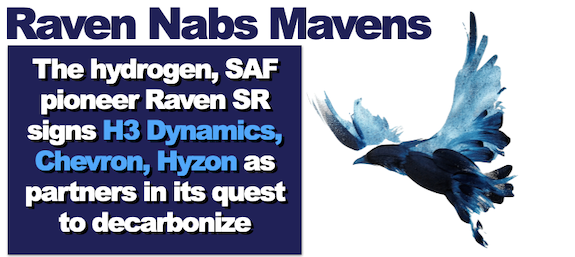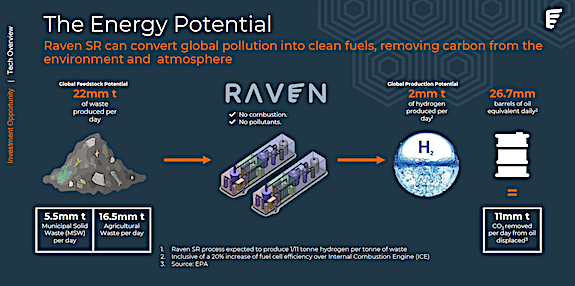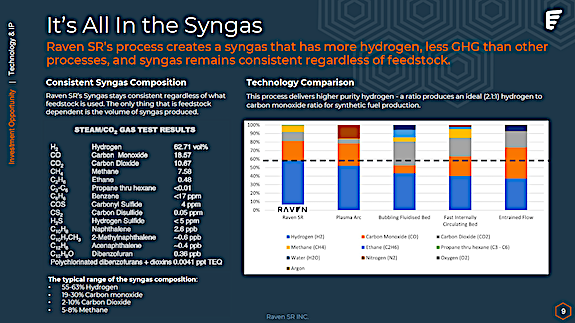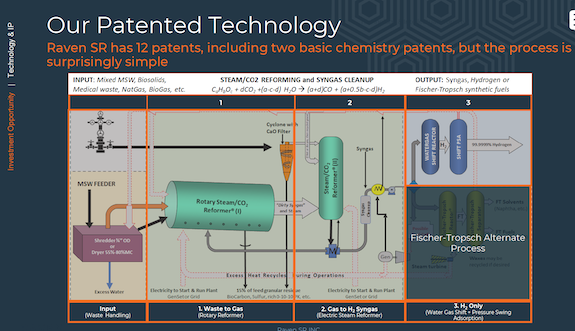Raven Nabs Mavens: The hydrogen pioneer signs H3 Dynamics, Chevron, Hyzon as partners in its quest to decarbonize

In Wyoming, Raven SR and hydrogen aviation developer H3 Dynamics have inked an MOU to collaborate on waste-to-hydrogen energy systems to support the decarbonization of airport operations and the adoption of hydrogen at airports.
H3 Dynamics will provide hydrogen power systems to replace conventional fuel and other energy sources at airports, especially in Asia, Europe and the U.S. Raven SR will provide renewable hydrogen production facilities to supply airports. The use of hydrogen to power various ground operations will help reduce emissions at airports.
H3 Dynamics will work with its technology and manufacturing partners to configure hydrogen power systems componentry to meet certification requirements within the airport and aircraft environment.
The Raven backstory: The Chevron Hyzon nexus
Earlier this month, we reported that Chevron and Hyzon Motors said they are working on a commercial green waste-to-hydrogen project for Northern California, owned by a newly formed company, Raven SR S1. Raven SR will be the operator of the facility, which is targeted to come online in the first quarter of 2024. Chevron holds a 50% equity stake in Raven SR 1. Raven SR holds a 30% stake and Hyzon owns the remaining 20%. And we reported on SAF offtake deals with ANA and JAL.

To produce the hydrogen, the project is expected to divert up to 99 wet tons of green and food waste per day from Republic Services’ West Contra Costa Sanitary Landfill into its non-combustion Steam/CO2 Reforming process, producing up to 2,400 metric-tons per year of renewable hydrogen. Diversion of this organic waste will help fulfill California’s SB 1383 mandates, and will potentially avoid up to 7,200 metric-tons per year of CO2 emissions from the landfill. In addition, Raven’s technology uses no fresh water, an important element given drought risks in California, and uses less electricity to power its units than competing processes. The project is expected to produce at least 60% of its own electricity by upgrading the currently permitted and zoned landfill gas electric generators at the landfill, further reducing both the current air emissions and the need for grid power for its non-combustion process.
Chevron plans to market its share of the hydrogen in Bay Area and Northern California fueling stations, enabling the energy transition to zero emission vehicles. Hyzon, a global supplier of fuel cell electric commercial vehicles, plans to provide refueling for hydrogen fuel cell trucks at a hydrogen hub in Richmond.

The Raven SR technology
The Raven SR technology is a non-combustion thermal, chemical reductive process that converts organic waste and landfill gas to hydrogen and Fischer-Tropsch synthetic fuels. Unlike other hydrogen production technologies such as electrolysis, Raven SR’s Steam/CO2 reformation does not require fresh water as a feedstock. The process is more efficient than conventional hydrogen production and can deliver fuel with low to negative carbon intensity. Additionally, Raven SR’s goal is to generate as much of its own power onsite as possible to reduce reliance on the power grid and even be independent of the grid. Its modular design provides a scalable means to locally produce renewable hydrogen and synthetic liquid fuels from local waste. We reported in depth on the technology here.

The H3 backstory
H3 Dynamics focuses on decarbonizing aviation using distributed hydrogen-electric propulsion, hydrogen refueling and airport power solutions. The company is based in Toulouse, Austin and Singapore. h3dynamics.com.
Reaction from the stakeholders
“We see tremendous demand to decarbonize the aviation sector with renewable fuels, including on the ground,” said Matt Murdock, CEO of Raven SR. “By collaborating with H3 Dynamics, we can reach a broader network among airports and equipment, including a variety of aircraft operations, to install waste-to-energy hubs where there is an acute need to curb emissions.”
“Raven SR provides a way to convert a variety of waste feedstocks into clean hydrogen, with a process that uses less energy than other renewable hydrogen production. Raven SR’s advanced waste-to-hydrogen technology offers a less intensive, more sustainable means of locally producing fuel,” said Taras Wankewycz, CEO of H3 Dynamics.
“H3 Dynamics will deploy decarbonization use cases that have a more immediate impact, so that the infrastructure built today can also welcome hydrogen aircraft in the future,” said Wankewycz.
“Our strategic partners’ commitment to the first non-combustion Steam/CO2 facility in the world will help drive our commercial operations in Richmond and accelerate similar facilities globally,” said Matt Murdock, CEO of Raven. “This facility will be the first hydrogen production plant in the world to reduce greenhouse gases, including critically important short-lived climate pollutants, through its process and its product. By removing waste from the landfill, it will help reduce methane emissions. Not only will the greater Richmond community benefit from reduced emissions, investments, and jobs, it will also see economic benefits as local gas stations have a consistent supply of clean, zero-carbon hydrogen fuel for fuel cell vehicles. We are grateful to work with partners who share our mission to make cleaner fuel options available as soon as possible.”
“We are excited about this collaboration and our expanded commitment to Raven and its waste-to-hydrogen technology,” said Austin Knight, vice president of Hydrogen for Chevron New Energies. “Not only are we positioned to commercialize a first-of-its-kind lower carbon hydrogen project, we are working to reduce emissions in a community in which we have a long and proud history. With a relatively short lead time, we will be able to further develop the hydrogen ecosystem in the region.”
“The Richmond hub enables a local, renewable hydrogen ecosystem by aligning hydrogen production, refueling infrastructure and vehicle availability geographically and technologically. This alignment is expected to reduce total costs to fleet operators, accelerating the transition to zero-emissions vehicles and global decarbonization,” said Parker Meeks, Hyzon president and interim CEO.
“This marks a significant step in demonstrating the commercial viability of a localized, low-to-negative carbon intensity hydrogen economy,” he added. “Through Hyzon’s partnership with Raven, hydrogen supply can be synchronized with the demand for hydrogen fuel cell electric vehicles. Raven’s deployment of scalable hydrogen production facilities allows supply and demand to grow together as clean hydrogen for transport continues to gain market and regulatory support.”
Category: Top Stories















